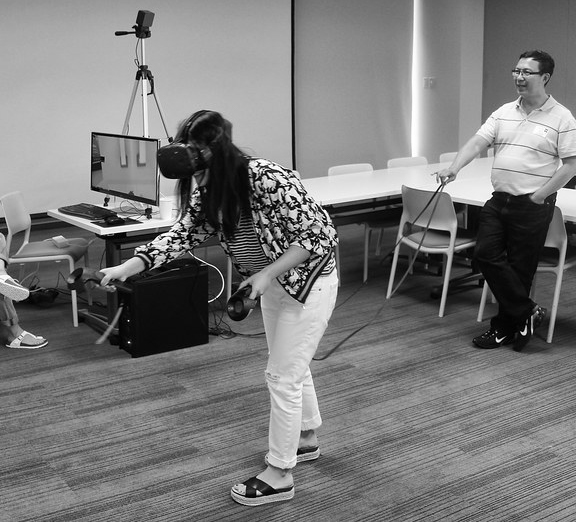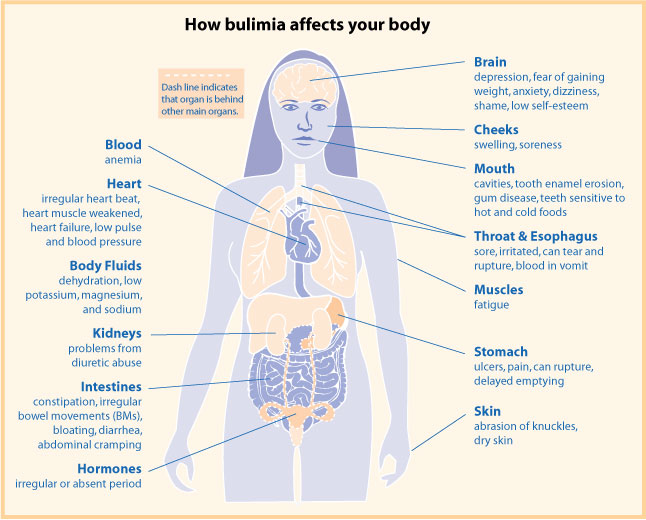|
Body Image Disturbance
Body image disturbance (BID) is a common symptom in patients with eating disorders and is characterized by an altered Body image, perception of one's own body. The onset is mainly attributed to patients with anorexia nervosa who persistently tend to subjectively discern themselves as average or overweight despite adequate, clinical grounds for a classification of being considerably or severely underweight. The symptom is an altered perception of one's body and a severe state of bodily dissatisfaction characterizing the body image disturbance. It is included among the diagnostic criteria for anorexia nervosa in DSM-5 (Anorexia nervosa#DSM-5, criterion C). The disturbance is associated with significant bodily dissatisfaction and is a source of severe distress, often persisting even after seeking treatment for an eating disorder, and is regarded as difficult to treat. Thus, effective body image interventions could improve the prognosis of patients with ED, as experts have suggeste ... [...More Info...] [...Related Items...] OR: [Wikipedia] [Google] [Baidu] |
Psychiatry
Psychiatry is the medical specialty devoted to the diagnosis, treatment, and prevention of deleterious mental disorder, mental conditions. These include matters related to cognition, perceptions, Mood (psychology), mood, emotion, and behavior. Initial psychiatric assessment of a person begins with creating a Medical history, case history and conducting a mental status examination. Laboratory tests, physical examinations, and psychological tests may be conducted. On occasion, neuroimaging or neurophysiological studies are performed. Mental disorders are diagnosed in accordance with diagnostic manuals such as the ''International Classification of Diseases'' (ICD), edited by the World Health Organization (WHO), and the ''Diagnostic and Statistical Manual of Mental Disorders'' (DSM), published by the American Psychiatric Association (APA). The fifth edition of the DSM (DSM-5) was published in May 2013. Treatment may include psychotropics (psychiatric medicines), psychotherapy, su ... [...More Info...] [...Related Items...] OR: [Wikipedia] [Google] [Baidu] |
Hermann Munk
Hermann Munk (3 February 1839 – 1 October 1912) was a German physiologist. He was born at Posen, studied at Berlin and Göttingen, and in 1862 became docent in the former university. Seven years afterward he was promoted to assistant professor, and in 1876 to professor of physiology at the veterinary college at Berlin. Besides studies on the productive methods of threadworms, Munk wrote on the physiology of the nerves and especially on the brain The brain is an organ (biology), organ that serves as the center of the nervous system in all vertebrate and most invertebrate animals. It consists of nervous tissue and is typically located in the head (cephalization), usually near organs for .... Visual cortex Hermann Munk made important contributions to the field of psychology regarding the route from the eye to the brain through his meticulous research methods.The Human Brain and Spinal Cord: A Historical Study Illustrated by Writings from Antiquity to the Twentieth Centu ... [...More Info...] [...Related Items...] OR: [Wikipedia] [Google] [Baidu] |
Binge Eating Disorder
Binge eating disorder (BED) is an eating disorder characterized by frequent and recurrent binge eating episodes with associated negative psychological and social problems, but without the compensatory behaviors common to bulimia nervosa, OSFED, or the binge-purge subtype of anorexia nervosa. BED is a recently described condition, which was introduced to distinguish binge eating similar to that seen in bulimia nervosa but without characteristic purging. Individuals who are diagnosed with bulimia nervosa or binge eating disorder exhibit similar patterns of compulsive overeating, neurobiological features such as dysfunctional cognitive control and food addiction, and biological and environmental risk factors. Some professionals consider BED to be a milder form of bulimia, with the two conditions on the same spectrum. Binge eating is one of the most prevalent eating disorders among adults, though it receives less media coverage and research about the disorder compared to anorexi ... [...More Info...] [...Related Items...] OR: [Wikipedia] [Google] [Baidu] |
Bulimia Nervosa
Bulimia nervosa, also known simply as bulimia, is an eating disorder characterized by binge eating (eating large quantities of food in a short period of time, often feeling out of control) followed by compensatory behaviors, such as self-induced vomiting or fasting, to prevent weight gain. Other efforts to lose weight may include the use of diuretics, laxatives, stimulants, water fasting, or excessive exercise. Most people with bulimia are at normal weight and have higher risk for other mental disorders, such as depression, anxiety, borderline personality disorder, bipolar disorder, and problems with drugs to alcohol. There is also a higher risk of suicide and self-harm. Bulimia is more common among those who have a close relative with the condition. The percentage risk that is estimated to be due to genetics is between 30% and 80%. Other risk factors for the disease include psychological stress, cultural pressure to attain a certain body type, poor self-esteem, and obes ... [...More Info...] [...Related Items...] OR: [Wikipedia] [Google] [Baidu] |
Hilde Bruch, Clinical Professor Of Psychiatry
Hilde may refer to: * Hilde (given name) * ''Hilde'' (film), a 2009 German biopic film * MV ''Hilde'', a Kriegsmarine coastal tanker * Tom Hilde (born 1987), Norwegian ski jumper Characters * Hilde (Soulcalibur), a character in the ''Soul'' series * Hilde Schbeiker, a character in ''Mobile Suit Gundam Wing'' *Hilde Schmittendorf, minor vilan in Dead Rising 3 * Hilde (7 days), a character in "7 days" mobile game See also * Hild (other) * Hilda (other) {{disambiguation ... [...More Info...] [...Related Items...] OR: [Wikipedia] [Google] [Baidu] |
Hilde Bruch
Hilde Bruch (March 11, 1904 December 15, 1984) was a German-born American psychiatrist and psychoanalyst, known foremost for her work on eating disorders and obesity. Bruch emigrated to the United States in 1934. She worked and studied at various medical facilities in New York City and Baltimore before becoming a professor of psychiatry at Baylor College of Medicine in Houston in 1964. In 1973 she published her seminal work ''Eating Disorders'': ''Obesity, Anorexia Nervosa, and the Person Within''. This book was based on observations and treatments of eating disorders, such as anorexia nervosa, over several decades. In 1978 she published ''The Golden Cage: the Enigma of Anorexia Nervosa,'' a distillation of ''Eating Disorders'' aimed at the lay reader. Her other works include ''Don't Be Afraid of Your Child'' (1952), ''The Importance of Overweight'' (1957), and ''Learning Psychotherapy: Rationale and Ground Rules'' (1974). A final work, ''Conversations with Anorexics'' (198 ... [...More Info...] [...Related Items...] OR: [Wikipedia] [Google] [Baidu] |
Schizophrenia
Schizophrenia () is a mental disorder characterized variously by hallucinations (typically, Auditory hallucination#Schizophrenia, hearing voices), delusions, thought disorder, disorganized thinking and behavior, and Reduced affect display, flat or inappropriate affect. Symptoms Prodrome, develop gradually and typically begin during young adulthood and rarely resolve. There is no objective diagnostic test; diagnosis is based on observed behavior, a psychiatric history that includes the person's reported experiences, and reports of others familiar with the person. For a diagnosis of schizophrenia, the described symptoms need to have been present for at least six months (according to the DSM-5) or one month (according to the ICD-11). Many people with schizophrenia have other mental disorders, especially mood disorder, mood, anxiety disorder, anxiety, and substance use disorders, substance use disorders, as well as obsessive–compulsive disorder (OCD). About 0.3% to 0.7% of peo ... [...More Info...] [...Related Items...] OR: [Wikipedia] [Google] [Baidu] |
Kurt Schneider
Kurt Schneider (7 January 1887 – 27 October 1967) was a German psychiatrist known largely for his writing on the diagnosis and understanding of schizophrenia, as well as personality disorders then known as psychopathic personalities. Biography Schneider was born in Crailsheim, Kingdom of Württemberg in 1887. He began his psychiatric training in Cologne; however, his training was interrupted by the first World War, in which he served on the Western Front. When his post-war career began, Schneider was influenced and mentored by Max Scheler, a philosophy professor and one of the co-founders of the phenomenological movement in philosophy. Scheler served as Schneider’s supervisor for his postgraduate degree in philosophy in 1921. Schneider applied Scheler’s theory of emotions to his studies and this theory was the topic of his first major publications. In 1931 he became director of the German Psychiatric Research Institute in Munich, which was founded by Emi ... [...More Info...] [...Related Items...] OR: [Wikipedia] [Google] [Baidu] |
Phantom Limb Syndrome
A phantom limb is the sensation that an amputation, amputated or missing limb (anatomy), limb is still attached. It is a chronic condition that is often resistant to treatment. When the cut ends of sensory fibres are stimulated during thigh movements, the patient feels as if the sensation is arising from the non-existent limb. Sometimes, the patient might feel pain in the non-existent limb. Approximately 80–100% of individuals with an amputation experience sensations in their amputated limb. However, only a small percentage will experience painful phantom limb sensations (phantom pain). These sensations are relatively common in amputees and usually resolve within two to three years without treatment. Research continues to explore the underlying mechanisms of phantom limb pain (PLP) and effective treatment options. Signs and symptoms Most (80–100%) amputees experience a phantom limb, with some of them having non-painful sensations. The amputee may feel very strongly that the p ... [...More Info...] [...Related Items...] OR: [Wikipedia] [Google] [Baidu] |
Neurological Damage
Nerve injury is an injury to a nerve. There is no single classification system that can describe all the many variations of nerve injuries. In 1941, Herbert Seddon introduced a classification of nerve injuries based on three main types of nerve fiber injury and whether there is continuity of the nerve. Usually, however, nerve injuries are classified in five stages, based on the extent of damage to both the nerve and the surrounding connective tissue, since supporting glial cells may be involved. Unlike in the central nervous system, neuroregeneration in the peripheral nervous system is possible. The processes that occur in peripheral regeneration can be divided into the following major events: Wallerian degeneration, axon regeneration/growth, and reinnervation of nervous tissue. The events that occur in peripheral regeneration occur with respect to the axis of the nerve injury. The proximal stump refers to the end of the injured neuron that is still attached to the neuron cel ... [...More Info...] [...Related Items...] OR: [Wikipedia] [Google] [Baidu] |
French Language
French ( or ) is a Romance languages, Romance language of the Indo-European languages, Indo-European family. Like all other Romance languages, it descended from the Vulgar Latin of the Roman Empire. French evolved from Northern Old Gallo-Romance, a descendant of the Latin spoken in Northern Gaul. Its closest relatives are the other langues d'oïl—languages historically spoken in northern France and in southern Belgium, which French (Francien language, Francien) largely supplanted. It was also substratum (linguistics), influenced by native Celtic languages of Northern Roman Gaul and by the Germanic languages, Germanic Frankish language of the post-Roman Franks, Frankish invaders. As a result of French and Belgian colonialism from the 16th century onward, it was introduced to new territories in the Americas, Africa, and Asia, and numerous French-based creole languages, most notably Haitian Creole, were established. A French-speaking person or nation may be referred to as Fra ... [...More Info...] [...Related Items...] OR: [Wikipedia] [Google] [Baidu] |
Pierre Bonnier
Pierre Bonnier (16 August 1861 in Templeuve – 22 March 1918 in Paris) was a French otologist. He was the brother of architect Louis Bonnier (1856–1946). He studied medicine in Paris, and in 1897 began work as an assistant in the medical clinic of the Hôtel-Dieu in Paris. In 1901 he was named president of Société d’Otologie et de Laryngologie de Paris. He was a member of the Institut Psychologique (from 1902) and the Société de Neurologie (from 1903).Classic Cases in Neuropsychology, Volume 2 edited by Chris Code, Yves Joanette, Andre Roch Lecours, Claus-W. Wallesch He specialized in research of auditory and |





